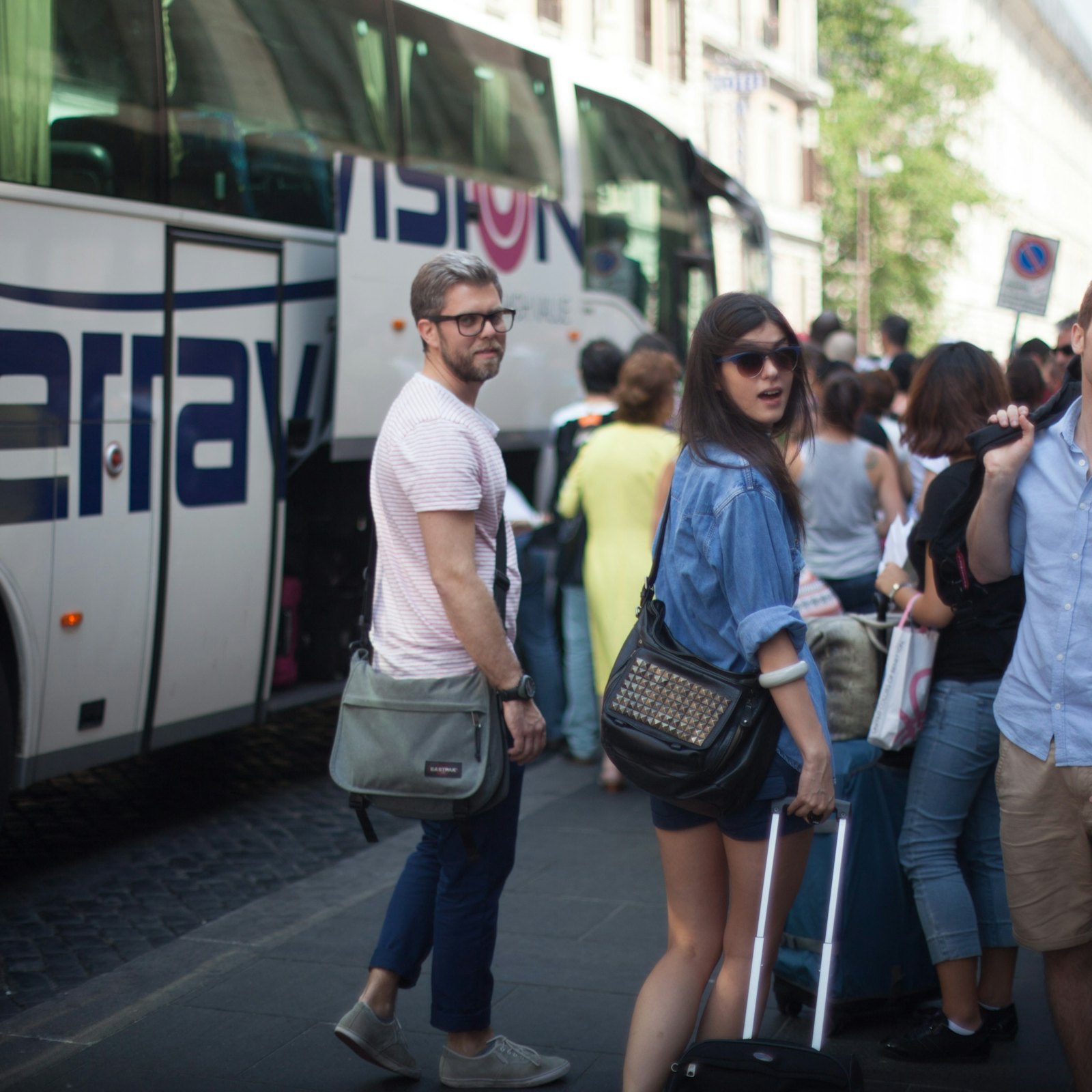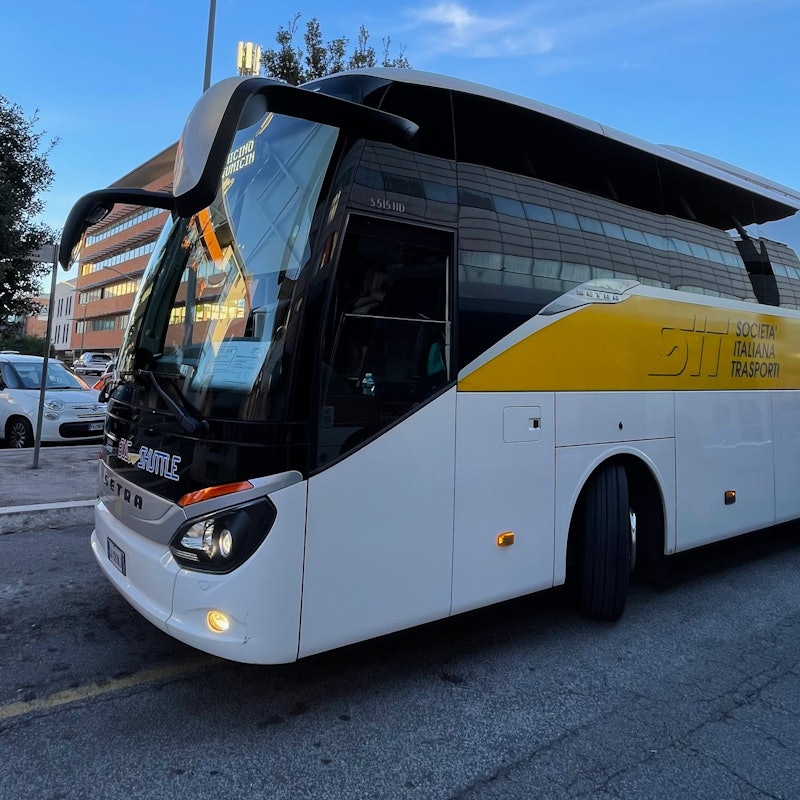Shuttle Bus Fiumicino Airport to/from Rome
Choose the cheap, convenient way to travel between Fiumicino Airport and Rome
- Rome Fiumicino Airport Transfers
- WIFI Onboard
More info
Less info

Excellent
This is some text inside of a div block.
This is some text inside of a div block.
This is some text inside of a div block.
From
€6.00
BESTSELLER
Rome Airport Transfer Options - Tickets and Information
{{ticket-block-triple}}
There are two airports in Rome:
- Leonardo da Vinci International Airport is in Fiumicino and is often referred to as 'Fiumicino Airport' or FCO Airport for short.
- Ciampino Airport is on the southeast of Rome and known as CIA Airport for short.
Leonardo da Vinci International Airport - FIUMICINO to Rome City Options
COACH OPTIONS
Coach Transfer From Fiumicino Airport to Rome Termini Railway Station
- Tickets from just €6.00
- Free WiFi on board
- Duration: 55-mins
- Free to take luggage
Coach Transfer from Rome Termini Railway Station to Fiumicino Airport
- Tickets from just €6.00
- Free WiFi on board
- Free to take luggage
TRAIN OPTIONS
Leonardo Express: High Speed Train from Fiumicino Airport to Rome Termini City Station
- Tickets from €17.90
- FROM FCO To Rome Termini
- Duration: 32 minutes
- First Train at 06:08 AM and running until 23:23.
- Trains run every 15-20 minutes.
- Trains guaranteed even in the event of a strike.
Leonardo Express: High Speed Train from Rome Termini City Station to Fiumicino Airport
- Tickets from €17.90
- From Rome Termini to FCO
- Duration: 32 minutes
- First Train at 05:35 AM until 22:35
- Trains run every 15-20 minutes
- Trains guaranteed even in the even of a strike.
CIAMPINO Airport Transfer Options
Coach Transfers from Ciampino (CIA) Airport to Rome Termini City Station
- Tickets from €6.00
- Duration: Around 40 minutes
- Free WiFi Options
- Round-trip ticket options (also saves money)
- One-Way Ticket Option from Ciampino (CIA) Airport to Rome Termini Station
- One-Way Ticket Option from Rome Termini Station to Ciampino (CIA) Airport
Coach Times
- Ciampino – Roma Termini: 3.30 – 5.45 – 8.10 - 8.40 – 9.20 – 10.30 – 11.10 – 12.00 – 13.15– 14.00 – 15.20 – 16.00 – 16.30 – 17.00 – 19.00 – 20.00 – 23.30
- Roma Termini – Ciampino: 00.05 – 00.30 – 4.15 – 6.20 – 7.45 – 9.30 – 10.20 – 11.50 –12.50 – 13.40 – 14.25 – 14.50 – 15.20 – 16.15 – 17.00 – 17.45 – 18.30 – 19.40 – 21.00 –21.30 – 22.00
Coach Transfers from Rome Termini City Station to Ciampino (CIA) Airport
- Tickets from €6.00
- Duration: Around 40 minutes
- Free WiFi Options
- Round-trip ticket options (also saves money)
- One-Way Ticket Option from Ciampino (CIA) Airport to Rome Termini Station
- One-Way Ticket Option from Rome Termini Station to Ciampino (CIA) Airport
Popular Tickets
Popular Attractions
No items found.
Tips for Visiting Rome
Plan Your Visits to Major Attractions
- Colosseum and Vatican: Both are incredibly popular and can have long lines at the ticket office. We suggest booking tickets in advance online to help save some time.
- Off-Peak Hours: Visit major sites early in the morning or late in the afternoon as they can sometimes have smaller crowds at those times.
Explore Beyond the Main Sites
- Lesser Known Areas: Wander through neighbourhoods like 'Trastevere', 'Monti', and 'Testaccio' to experience local life, find charming streets, and discover lesser-known historical sites.
- Local Markets: Visit markets like 'Campo de' Fiori' or 'Mercato Testaccio' for fresh produce, local delicacies, and a glimpse into everyday Roman life.
Use Public Transport and Walk
- Metro and Buses: Rome's metro and bus systems are efficient and can help you get around the city easily. Our Roma Pass or a transport pass can save you money if you plan to use public transport frequently.
- Walking: Rome is a city best explored on foot, with many attractions close to each other. Wear comfortable shoes and be prepared to walk a lot.
Stay Hydrated and Enjoy Italian Cuisine
- Water Fountains: Rome has numerous public drinking fountains (nasoni) with clean, freshwater. Carry a reusable water bottle to stay hydrated, especially during the summer when it does get hot.
- Food: Enjoy Roman specialties like pasta carbonara, cacio e pepe, and supplì. Look for trattorias and osterias where locals dine to get authentic and delicious meals.
Respect Local Customs and Etiquette
- Dress Code: When visiting sites such as St. Peter's Basilica, remember they are religious sites as well as tourist attractions so dress modestly with shoulders and knees covered.
- Siesta Time: Be aware that some shops and restaurants may close in the afternoon for a few hours. Plan your day accordingly to avoid inconvenience.
Tips for Visiting Rome
Why book with us?





























